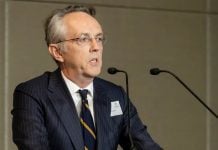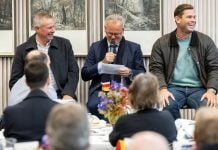Dr Mark Cabouret (OM 1971) has had what could be described as a dual career. Having read Zoology, Psychology and Medicine at the University of Melbourne and Royal Melbourne Hospital, he commenced training in psychiatry at Prince Henry’s Hospital in 1983.
Mark is also a passionate ornithological art historian and collector and coincidently embarked on an almost uninterrupted program of research, becoming the world expert on the lives and work of four of Australia’s most important early ornithological artists – Neville Henry Cayley (1854 – 1903), Neville William Cayley (1886 – 1950), Alice Rochfort Cayley (1889 – 1960) and John Mitchell Cantle (1849 – 1919).
Protecting an Australian artistic legacy
Mark developed his passion for the natural world as a child growing up at Mount Macedon, where he spent much of his time exploring the bush. “The forest was where I learned to observe, listen, and understand,” he says. “My mother taught me to look for patterns without a prejudicial view. That attitude has informed my life, not only in my research into the art and literature of Australian ornithology but also in my work in medicine.”
Acquiring examples of the meticulous watercolours of Australian birds by Neville Henry Cayley, he experienced a sense of recognition. “There was such a sense of resonance with what I knew as a child,” says Mark. “Cayley had been dismissed by art historians and in turn the public as an ‘itinerant alcoholic’ who dashed off paintings of variable quality. Intuitively, I sensed there was much more to his story and myth had eclipsed reality.”
Undaunted by lack of training in fine art, Mark felt confident that scientific integrity guiding research based on primary source material rather than speculation and retailing other authors’ opinions would speak most eloquently in revealing the artist and his work.
“I believe in undertaking intensive research into my subject and collecting everything that is relevant to promoting the aims of that research,” he explains.
Mark’s research has been entirely self-funded, and he remains as inspired by discovery today as at the outset 40 years ago. His work has been published by the State Library of Victoria, international journals and by the Australiana Society Inc in Sydney and in December 2014, he established his own publishing house of NATURALISTES ET CHASSEURS which produced his monograph on the virtually unknown history of Neville Henry Cayley in Victoria.
In October 2023, the Australiana Society Inc published their inaugural monograph being Mark’s deeply researched account of John Mitchell Cantle, Australia’s first native-born ornithological draughtsman. The work includes nearly 700 illustrations, the vast majority derived from Mark’s own reference collection. He also designed every aspect of the production demonstrating remarkable innovation in rendering both text and images accessible and inspiring.
The energy and determination needed to locate, identify, validate and where possible acquire each artwork was only possible through Mark’s steadfast focus referred to in the Foreword written by Christine E. Jackson FLS, internationally acclaimed doyenne in the history of ornithological art and literature.
Dr Mark Cabouret has re-instated four Australian artist-naturalists: Neville Cayley, both father and son, Alice Cayley and now John Cantle. He has achieved this by his enthusiasm, deep and long research and total commitment over many years to his ambition to see these people given their proper place in Australian natural history. Dr Cabouret’s achievement stands alongside theirs, so that this detailed account of Cantle stands as a testimony to both men.…
Mark has six major publications well towards completion, those dealing with Neville Henry and Neville William Cayley, author and artist of the best-selling reference book What Bird Is That? A guide to the birds of Australia published in November 1931 as well as other important handbooks, currently amounting to 4,500 pages each in draft and calling on nearly 5,000 references. Mark has enjoyed the unqualified support of the Cayley family from the inception of his research.
Understanding the reasons for collecting
Mark sees his research and work in psychological medicine as entirely complementary, each informing the other and both guided by open-minded enquiry towards the shared benefit of greater understanding or insight. In November 2017, Mark combined these two areas of expertise in a substantially autobiographical account, Considerations on the psychology of collectors and collecting.
The following excerpt offers insight into Mark’s own motivation within his ornithological work and desire for his collection to remain intact into the future:
…Ultimately the distinction between the ‘unhealthy’ and ‘healthy’ collector is based on whether the activities of the collector are selfishly for themselves or altruistically for the benefit of all…
The ‘healthy’ collector … celebrates the creative achievements of others and their selfless attachment to their collections takes the form of sharing and ultimately passing on their collection to others or a public institution for its safeguard into the future…
“It’s taken a lifetime to create a seriously significant collection of art, the largest and most comprehensive ever assembled by these four artists,” says Mark. “As a collector, I see myself in a curatorial capacity, taking care of these physical objects. I collect for a purpose which is to create a vast reference collection which generates questions and helps to find the answers and in turn to create and promulgate new knowledge. I have done it to demonstrate the value of what the artists have contributed to Australia’s cultural heritage.”
How does this interest influence Mark’s day to day life? “Wherever I am, birds add a very welcome sense of continuum,” he says. “My patients in my waiting room in Collins Street see Rainbow Lorikeets come to my balcony along with six other endemic species while Peregrine and Little Falcons, Sulphur-crested Cockatoos and Yellow-tailed Black Cockatoos and corellas as well as kookaburras, magpies and Grey Currawongs, Wood Ducks and Black Ducks are also visible there in the city. No matter where I am, I am never far away from nature.”



